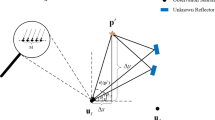Abstract
High-accuracy positioning plays an important role in future 5G-Advanced cellular networks. However, it is quite challenging to utilize 5G signals to estimate positioning parameters accurately under multipath environments. To establish a high-precision real-time location system (RTLS), which is suitable for indoor scenarios, advanced parameter estimation techniques with low computational complexity should be developed. This paper proposes a modified subspace-based time-of-arrival (TOA) estimation algorithm for 5G signals with ultra-high accuracy and reduced complexity under multipath environments. A novel smoothing scheme termed as grouped subcarrier smoothing (GSS) is proposed to reduce the dimension of the covariance matrix involved in typical subspace-based methods. Then, the computational complexity of the corresponding eigenspace calculation is reduced. The TOA estimation performance is enhanced by constructing multiple snapshots of the estimated channel frequency response vector in the frequency domain. Finally, the super-resolution TOA estimate can be obtained using only one orthogonal frequency division multiplexing (OFDM) symbol. Simulation results show that the proposed method achieves centimeter-level TOA estimation accuracy under multipath channels when the signal-to-noise ratio (SNR) is high.




Similar content being viewed by others
Data Availability
The datasets generated during the current study are available from the corresponding author by reasonable request.
References
G. Bellusci, G.J.M. Janssen, J. Yan, C.C.J.M. Tiberius, Model of distance and bandwidth dependency of TOA-based UWB ranging error. In: Proceedings of the IEEE International Conference on Ultra-Wideband, pp. 193–196 (2008)
L. Chen, X. Zhou, F. Chen, L.-L. Yang, R. Chen, Carrier phase ranging for indoor positioning with 5G NR signals. IEEE Internet Things J. 9(13), 10908–10919 (2022)
J.A. del Peral-Rosado, R. Raulefs, J.A. López-Salcedo, G. Seco-Granados, Survey of cellular mobile radio localization methods: from 1G to 5G. IEEE Commun. Surv. Tut. 20(2), 1124–1148 (2018)
X.R. Li, K. Pahlavan, Super-resolution TOA estimation with diversity for indoor geolocation. IEEE Trans. Wirel. Commun. 3(1), 224–234 (2004)
D. Oh, M. Kwak, J.-W. Chong, A subspace-based two-way ranging system using a chirp spread spectrum modem, robust to frequency offset. IEEE Trans. Wirel. Commun. 11(4), 1478–1487 (2012)
D. Oh, Y. Ju, J. Lee, An improved MVDR-like TOA estimation without EVD for high-resolution ranging system. IEEE Commun. Lett. 18(5), 753–756 (2014)
M. Oziewicz, On application of MUSIC algorithm to time delay estimation in OFDM channels. IEEE Trans. Broadcast. 51(2), 249–255 (2005)
M. Pan et al., Efficient joint DOA and TOA estimation for indoor positioning with 5G picocell base stations. IEEE Trans. Instrum. Meas. 71, 1–19 (2022)
V.U. Prabhu, D. Jalihal, An improved ESPRIT based time-of-arrival estimation algorithm for vehicular OFDM systems. In: Proceedings of the IEEE 69th Vehicular Technology Conference, pp. 1–4 (2009)
C.D. Richmond, Response of sample covariance based MVDR beamformer to imperfect look and inhomogeneities. IEEE Signal Process. Lett. 5(12), 325–327 (1998)
K. Shamaei, Z.M. Kassas, A joint TOA and DOA acquisition and tracking approach for positioning with LTE signals. IEEE Trans. Signal Process. 69, 2689–2705 (2021)
K. Shamaei, Z.M. Kassas, LTE receiver design and multipath analysis for navigation in urban environments. J. Inst. Navig. 65(4), 6550–675 (2018)
Study on channel model for frequencies from 0.5 to 100 GHz, 3rd Generation Partnership Project (3GPP), document TR 38.901 (2020)
P. Wang, Y.J. Morton, Multipath estimating delay lock loop for LTE signal TOA estimation in indoor and urban environments. IEEE Trans. Wirel. Commun. 19(8), 5518–5530 (2020)
P. Wang, Y.J. Morton, Improved time-of-arrival estimation algorithm for cellular signals in multipath fading channels. In: Proceedings of the IEEE/ION Position Location Navigation Symposium (PLANS), pp. 1–7 (2020)
Acknowledgements
This work was sponsored by the National Natural Science Foundation of China (No. 61771197) and Science and Technology Commission of Shanghai Municipality (Grant No. 22DZ2229004).
Author information
Authors and Affiliations
Corresponding author
Ethics declarations
Conflict of interest
The authors have no competing interests to declare that are relevant to the content of this article.
Additional information
Publisher's Note
Springer Nature remains neutral with regard to jurisdictional claims in published maps and institutional affiliations.
Rights and permissions
Springer Nature or its licensor (e.g. a society or other partner) holds exclusive rights to this article under a publishing agreement with the author(s) or other rightsholder(s); author self-archiving of the accepted manuscript version of this article is solely governed by the terms of such publishing agreement and applicable law.
About this article
Cite this article
Yao, Y., Zhao, K., Jiang, Z. et al. High-Precision Time-of-Arrival Estimation Algorithm for 5G-Advanced with Multipath Channel. Circuits Syst Signal Process 43, 2639–2655 (2024). https://doi.org/10.1007/s00034-023-02587-w
Received:
Revised:
Accepted:
Published:
Issue Date:
DOI: https://doi.org/10.1007/s00034-023-02587-w




